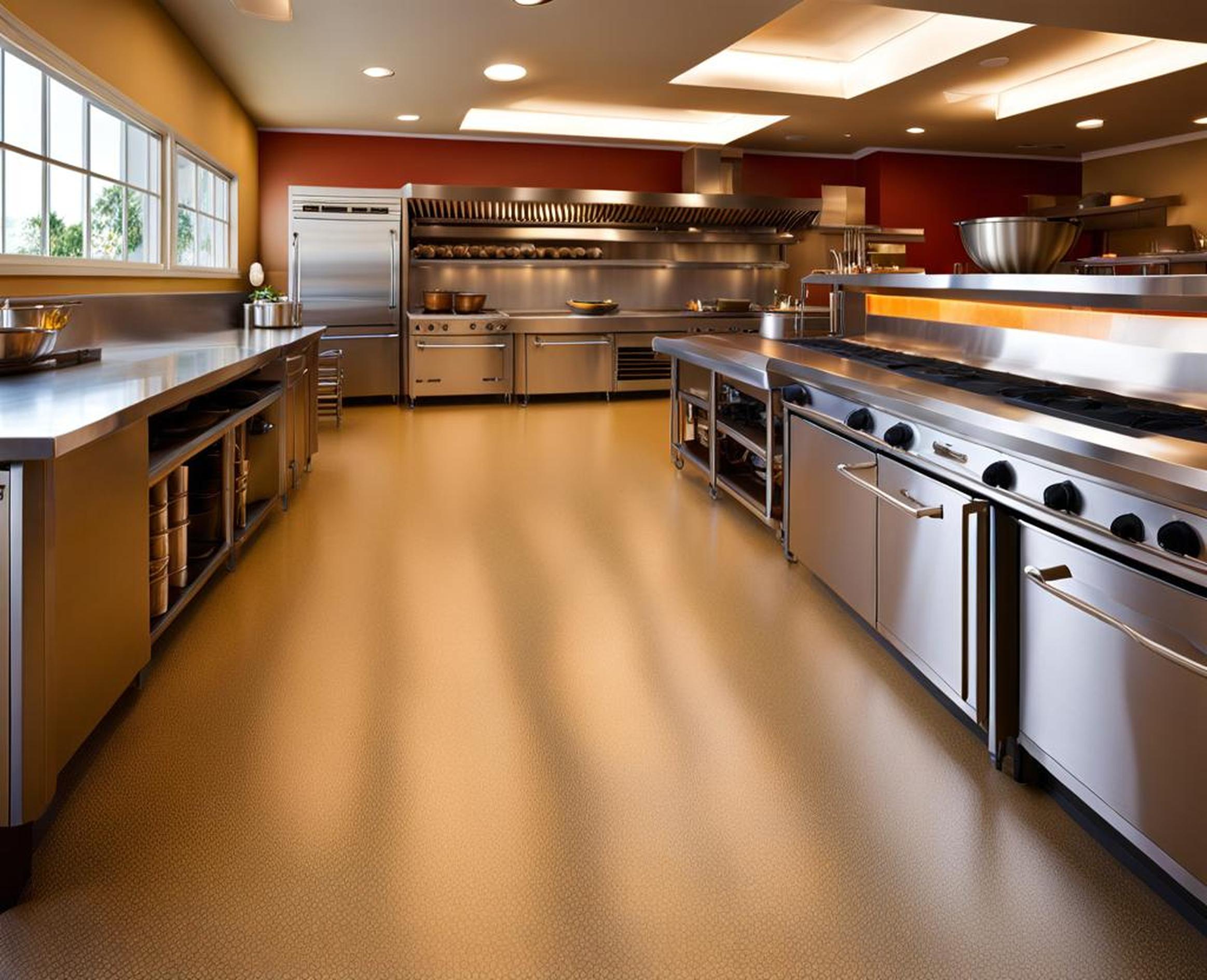Kitchen flooring is an incredibly important element in restaurant design and operations that is often overlooked. The right flooring choice can make the difference between seamless service and chaotic disruptions. When evaluating options, restauranteurs must consider factors such as safety, hygiene, noise, comfort, and costs.
Key Factors to Consider for Restaurant Kitchen Flooring
Safety
Safety should be the number one priority. Flooring needs to prevent slips, trips, and falls that can cause serious injuries. Options that offer slip resistance, especially when wet, are crucial.

Heat resistance is also important to avoid burns from hot pans and oil. Plus, proper electrical resistance ensures appliance safety. By selecting a flooring that promotes caution, restaurants protect their staff.
Cleanliness and Hygiene
Flooring must support proper sanitation to meet health codes. Non-porous, seamless surfaces that liquids can’t penetrate are ideal for cleanliness. Materials that resist grease, food particles, and spills simplify daily cleaning.
Floors should also be easy to sanitize with chemicals and heat. Simple mopping should restore hygienic conditions to maintain food safety standards.
Durability and Lifespan
High-traffic restaurant kitchens demand durable floors that can withstand heavy use. The material must be resilient against dropped knives, pots, grease spills, and other kitchen mishaps.
Stain-proof and scratch-proof qualities are also beneficial. Flooring that retains its structural integrity and appearance for years requires fewer repairs, reducing closures.
Noise Control
Hard floors in busy kitchens inevitably create loud environments that hinder communication. Acoustic control helps absorb noise for a quieter workspace.
This is especially important in high-traffic areas. Noise-reducing floors enhance staff focus and teamwork by improving how well they can hear each other.
Comfort Underfoot
Working long hours on hard, cold floors causes fatigue. Cushioned surfaces add softness and warmth underfoot for greater comfort.
This helps reduce back, leg, and joint strain from continuous standing. A comfortable kitchen floor keeps staff energized and productive.
Top Flooring Solutions for Restaurant Kitchens
Epoxy Flooring
Epoxy flooring provides a durable and seamless surface perfect for kitchens. The thick, glossy material creates a non-porous barrier that seamlessly covers the underfloor.
This excellent hygienic quality simplifies cleaning. Epoxy also offers superior resistance to impacts, chemicals, oils, and liquids. It’s a long-lasting flooring that retains its luster for years.
Visually, epoxy comes in endless color variations with custom pattern and design options. This allows restaurants to match their decor aesthetic.
Rubber Flooring
Rubber floor tiles offer cushioning that reduces leg and back strain during long shifts. The material has some natural flexibility and gives slightly underfoot.
It absorbs noise and sound, creating a quieter workspace. Textured surfaces on rubber floors improve traction and slip resistance.
With proper cleaning, rubber withstands heavy impacts from kitchen work. It also tolerates dropped knives or pots better than hard floors. Overall, it promotes safety and comfort.
Wood Flooring
Wood brings an upscale elegance and rustic feel that creates ambiance. Visually, it provides warm, natural tones that feel pleasant to work on.
However, wood requires intensive sealing and treatment to withstand spills and grease. Gaps must be filled properly to meet safety codes.
Frequent sanding and refinishing are needed to retain its appearance. Wood is also easily scratched and dented, necessitating constant maintenance.
Tile Flooring
Tile comes in a vast range of styles, colors, shapes, and patterns, allowing custom designs. It easily complements your brand aesthetic.
Tile floors resist moisture, food stains, and daily wear-and-tear. But the grout between tiles can trap debris and requires vigilance to keep clean.
The hard surface also doesn’t provide cushioning. Standing on tile for long periods leads to tired feet and legs.
Sheet Vinyl Flooring
Sheet vinyl is a cost-effective, low-maintenance solution. Seamless vinyl sheets simplify cleaning with few grooves that collect dirt.
While durable, vinyl can be prone to scuffs and stains over time – requiring increased maintenance. And some floors discolor or bubble with heat.
If installing vinyl tiles instead of sheet, the seams must be heat-welded to prevent moisture issues and dirt buildup between tiles.
Concrete Flooring
Concrete offers supreme durability to withstand heavy commercial use. With proper sealing, concrete is stain-proof and easy to clean.
It can last decades with minimal maintenance required. However, drops and impacts will crack and chip concrete over time, necessitating repairs.
The hard surface contributes to leg and joint pains. Cushioned mats are required for worker comfort and safety.
Factoring in Costs
Cost is a major factor when planning a new or replacement floor. Expenses include:
- Initial material and installation costs
- Long-term durability and lifespan
- Frequency and extent of maintenance needed
- Potential business disruptions during installation
While cheaper floors may save upfront, long-term costs could be higher with frequent repairs and replacements. Investing in durable, low-maintenance flooring often pays off.
Choosing the optimal restaurant kitchen flooring involves balancing many factors – from safety and hygiene to noise levels and visual appeal. Ultimately, the floor must perform under demanding commercial use.
Epoxy, rubber, and tile emerge as top solutions that check off critical boxes for cleanliness, durability, comfort, and aesthetics. While upfront costs may run higher, their longevity provides long-term value.
By selecting flooring that maximizes operations, staff performance, and food safety, restaurants gain a foundational element primed to deliver exceptional service for years to come.
